When I purchased this camera or actually two of them together with a bunch of lenses, I didn’t own a Hasselblad 500CM. For me it was all about getting back into shooting medium format film, though I already had a Mamiya M645, a camera that I liked but were lacking in some respects like not having a changeable film magazine.
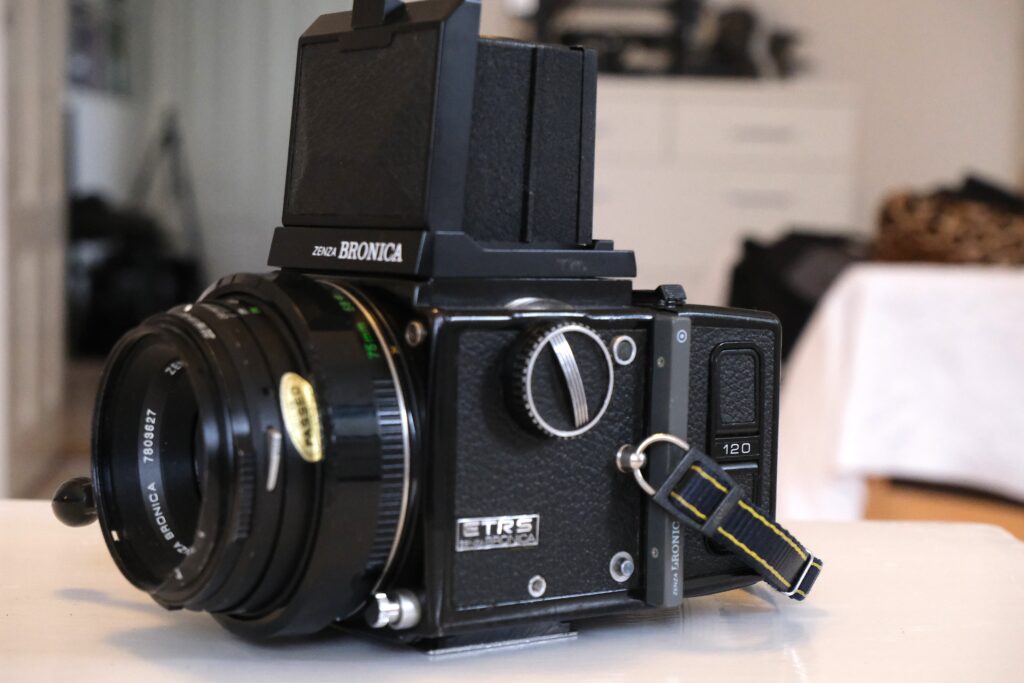
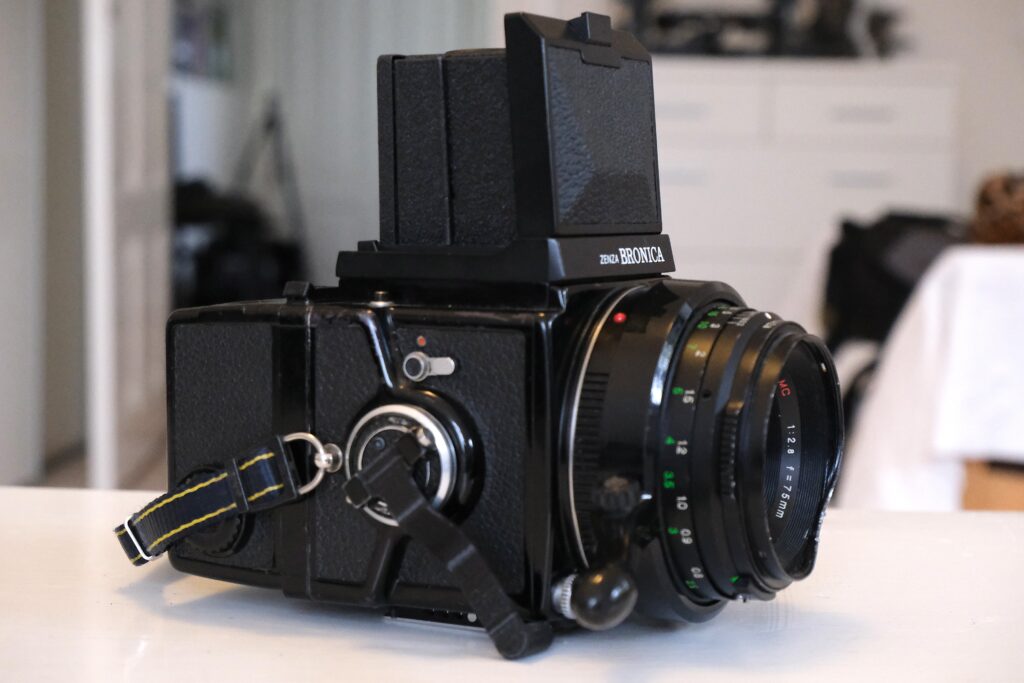
The Bronica ETR, ETRS, and ETRSi is a lineup of cameras, that resembles a Hasselblad 500 in many ways but also differs from it in some respects. Later I bought myself a Hasselblad 500CM and recently even both an SWC (Hasselblad Super Wide Camera – there is a first impressions video of that on Youtube, links below, and I’ll do a long term review when it’s back from repair) and a 2000FC (which has a focal plane shutter up to 1/2000 second – I’ll write a review of that later)
After having shot a lot on all these cameras, I am well aware of all the differences, and where the Bronica stands out, but also where it falls behind. So let’s delve into the details.
The Bronica ETRS and it’s earlier and later siblings are part of a very extensive camera system. These cameras are truly modular: Exchangeable backs, exchangeable lenses, exchangeable viewfinders (not on the early ETR), add-ons such as manual grip and motor grip. Main difference between the ETRS and the latest ETRSi is a mirror lock-up button.
Where the Bronica excels …
Where the Bronica ETRS excels is for instance with respect to its shutter time selection. There are two things here I like about the ETRS, one is that you select the shutter time on a dial on the camera body, which I prefer to the selection on the lens on the Hasselblad. This is of course subjective, and you may prefer the selection on the lens. It is important to note, that despite the selection on the camera body, the shutter is a leaf shutter sitting in the lenses, so you have flash synchronization on all shutter settings.
The other and more important is, that you have shutter times from 1/500 second (like on the Hasselblad) all the way up to 8 seconds. To me that is a real bonus for shooting at low light or when wanting to blur for instance a waterfall or make the sea calm. But you are depending on a battery, as the shutter control is electronic. If the battery fails you can shoot mechanically on only one setting: 1/500 second.
Weight and size is also differs between the Hasselblad and the Bronica, with the latter being both more compact and weighing less. It not an important point for me, but the difference is noticeable.
A major point for me is the diversity of film backs. You could say, that only 120 back will do, but I love the N 135 back, that make it possible to shoot 135 film on this camera. My viewfinder even has engravings for the 24×36 frame, so it’s very easy to get the right framing.
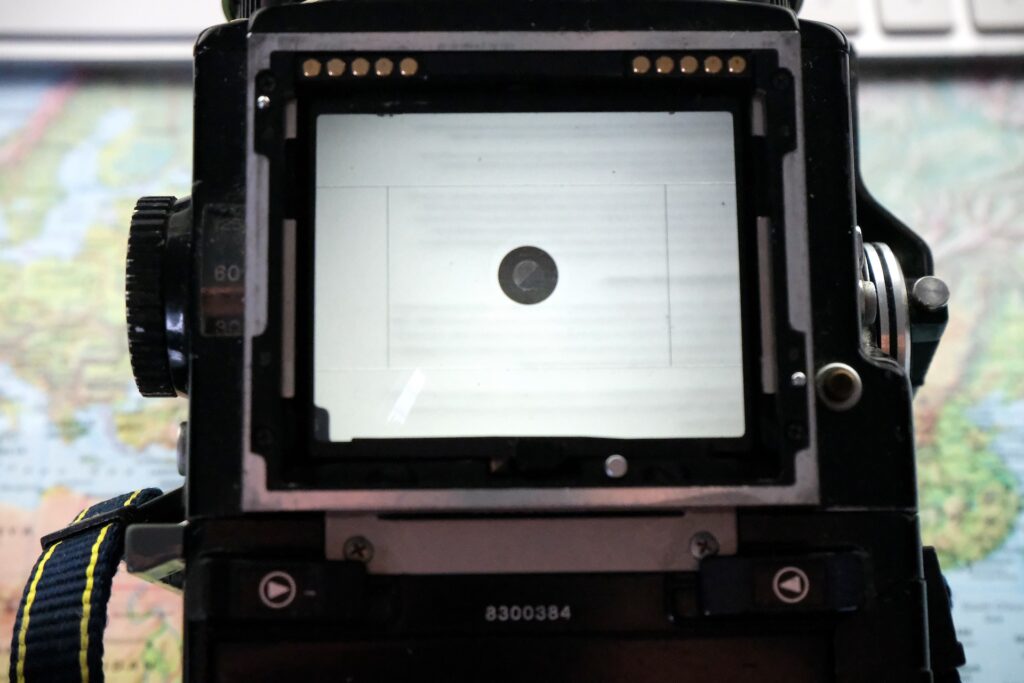
If you look at the image of the viewing screen, you’ll notice that the lines of 24×36 also extends right to the edge of the viewing screen. That’s due to something even more amazing, there is a W 135 back meant to shoot panoramic images on 135 film. Images of 24 by 56 mm can be created this way, how awesome is that, and definitely not something you’ll find in Hasselblad territory. The only downside is, that the back for shooting panoramic on 135 film is expensive, very expensive.
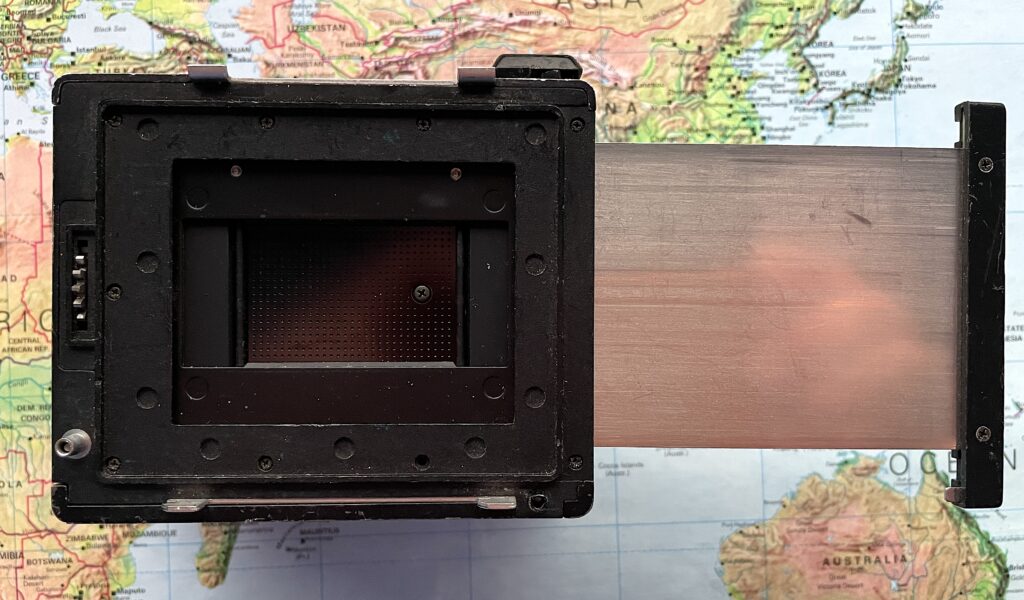
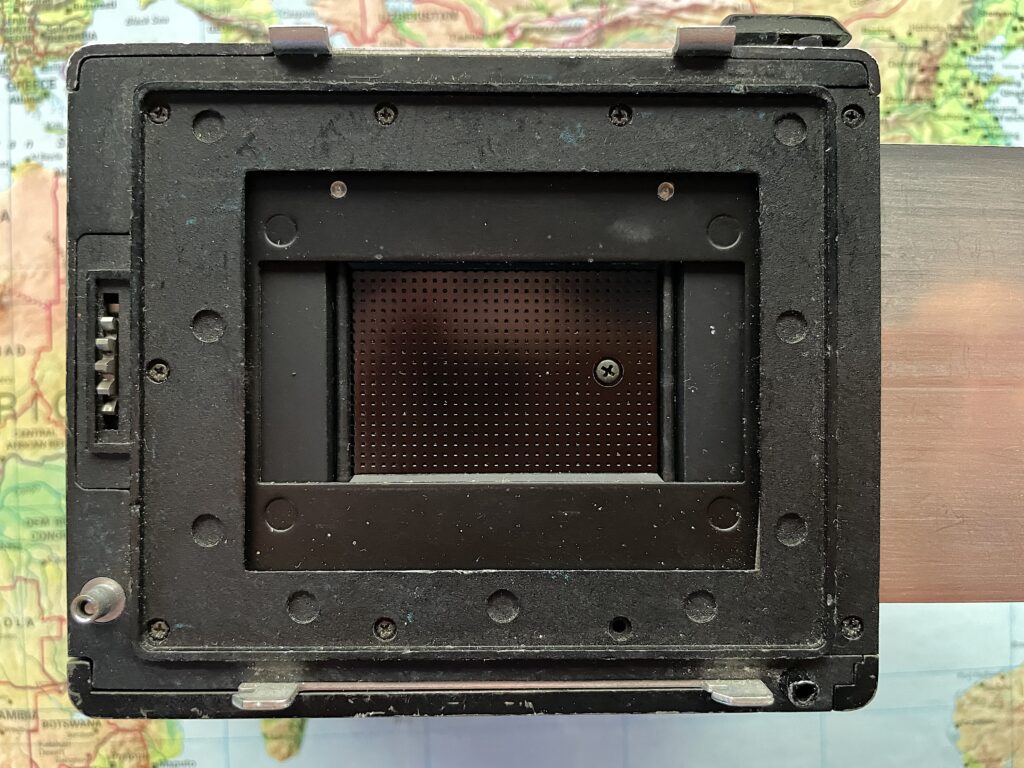
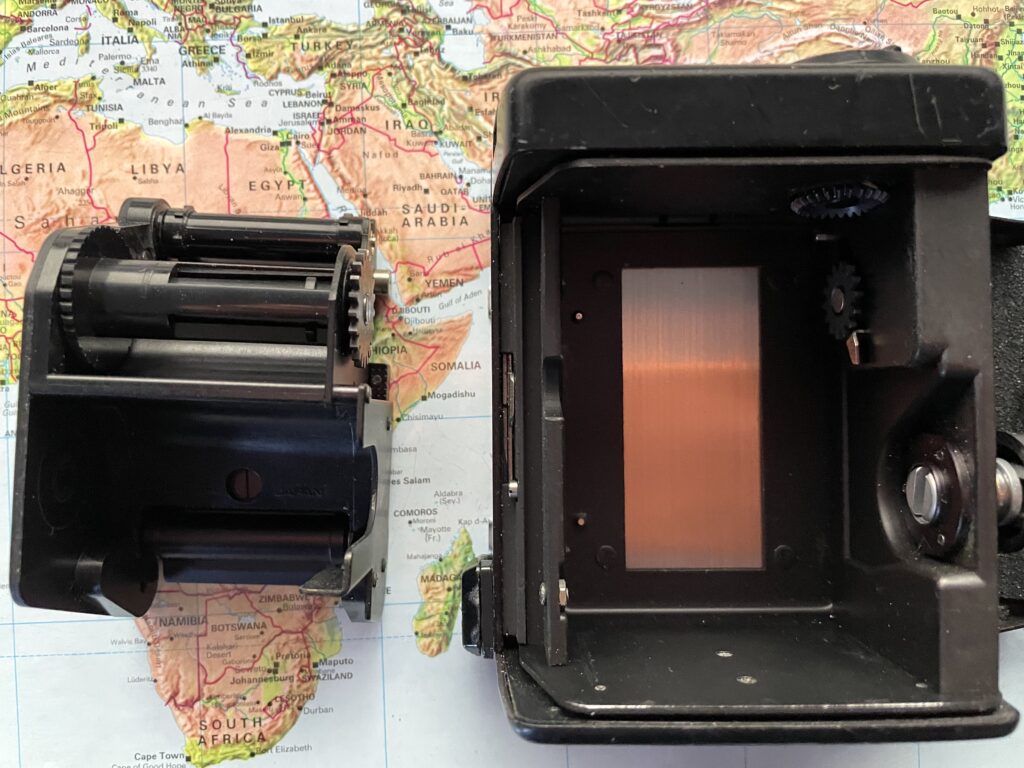
A last and for some (many?) very important point is price. The Hasselblads have really taken off and are becoming increasingly pricey, whereas Bronicas can be had for relatively small prices. I got my two Bronica ETRS bodies together with 6 lenses and 7 film backs of which one was a N 135 for less than I paid for my Hasselblad 500CM with one lens and one 120 back. So definitely a substantial price difference. Later I have sold one of the Bronicas together with two lenses and two backs ending up having a Bronica with 4 lenses and a number of backs for free. Also lenses are cheaper to buy on the used market, so apart from the W 135 back, it is cheaper to get into this system.
Where the Bronica falls behind …
Bronica ETRS falls behind the Hasselblad counterpart in some respects. With the landscape format of the 6×4.5 images it is difficult to shoot in portrait mode unless you use one of the prism finders. I love to use the waist level finders, but with that it is a real challenge to shoot in portrait mode. If you use the A16 magazine on the Hasselblad you run into the same issue, but this camera doesn’t shoot square format, therefore this issue is always present. I own a prism finder for the Hasselblad, so there is no issues for me, you can get one for the Bronica, but I don’t have a prism finder. On the other hand, many of my portraits from my travel include surroundings, as I prefer socalled “environmental portraits.” I therefore usually don’t care about the difficulty shooting in portrait mode, but your opinion on this might be quite the opposite.
As opposed to the Hasselblad, you are depending on a functioning battery, at least if you need to shoot at other shutter times than 1/500 second. It has never been an issue for me, as I have extra batteries with me, when I use this camera.
One difference, that actually not is a difference in the cameras as such, is that for the Hasselblad you have digital options, whereas for the Bronica to my knowledge there is and never has been digital backs available. Hasselblad released a digital back many years ago, and also companies like Mamiya Leaf and Phase One made digital backs, that could work with the Hasselblad cameras. Today it is even more easy, and you have options of choice as Hasselblad a few years ago released the CFV II 50C, a 50 megapixel digital back that works almost seamlessly with the Hasselblad cameras, and a few years later bettered it with the release of the CFV 100C, giving you an incredible 100 megapixel. The only downside to these digital backs are that they contain “only” 33×44 mm sized sensors. Some of the earlier options had considerably larger sensors.
For most parts, the cameras are very much alike
The in my opinion minor points described above doesn’t really distinguish the two camera system from one another. In the way you use these cameras they are very much if not identical then at least similar.
You load film into magazines, that can be exchanged mid shoot (there exists two Bronica models ETR-C and ETRC that don’t have exchangeable backs). You rely on lenses that have leaf shutters, so you can synchronize flash on any speed. You have a boxy film body that gives a reassuring sound, when you press the shutter. You have a wide selection of awesome lenses, and both systems supply really high quality optics, though the Hasselblad-Zeiss options might have a slight advantage here. In my opinion you’ll never notice any quality difference, but if the lenses are measured with advanced instruments, there will probably be a minor difference in favor of Hasselblad.
Given the price difference between the two systems, I would never hesitate to recommend the Bronica ETRS. If your budget is wide though, I would probably still go for Hasselblad, but you could get so much more Bronica equipment for the same money. That should definitely be considered in.
Links to Youtube videos:
Hasselblad SWC first impressions: https://youtu.be/9a7U0YXR9XU
Bronica ETRS review (available from Jan. 28th 2025): https://youtu.be/-g1PsOmA9YU
Mamiya ZD, a medium format DSLR with a large sensor: https://youtu.be/mgizIE0uALc
Model overview
- Bronica ETR. Released in 1976.
- Bronica ETR-C. Released in 1977. Like ETR, but lacks changeable backs.
- Bronica ETRS. Released in 1978, with changes to the electronic viewfinders.
- Bronica ETRC. Released in 1978. Like ETRS, but lacks changeable backs.
- Bronica ETRS New. Released in 1982. Like ETRS except the body is a lighter plastic body.
- Bronica ETRSi. Released in 1988. Adds mirror lock-up, and TTL flash functionality.
Many of the earliest lenses were produced by/in cooperation with Nikon, but some lenses were produced by the German Schneider-KREUZNACH. Bronica was taken over by lens manufacturer Tamron in 1995, and they added a few new lenses, including some zoom lenses, before they realized in 2004 that the world was going digital, and a closure of Bronica was decided.
Go out and shoot, no matter what camera you own. You can create stunning images with ANY camera, most important is the photographer and the ability visualize the end result. On my Youtube channel Key2adventure you’ll find much more inspiration to shoot on all kinds of cameras.